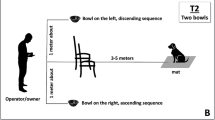Summary
The vibratory courtship signal generated by abdominal and leg movements of male Cupiennius salei on plants consists of impulses, which in groups of about ten form syllables. A syllable together with the preceding “silent” pause is called a sequence. Up to 50 sequences chained together form a series. A series together with the preceding silent period is called an interseries. A complete courtship is built up from a row of successive interseries. An additional signal produced by palpal drumming only occurs between syllables. Females respond to ca. 40% of the male signal series with a single irregular signal produced by leg oscillations and lasting for 113–1790 ms. Their response reduces the duration of the male interseries significantly from an average of 27.9 s to 20.6 s. The female signal follows a male signal series within a narrow time frame of 0.89±0.53 s. Analysis over long periods of time and of complete courtships showed the male signalling to be highly structured in the time domain and to contain many cues potentially usable by the female for both such precise timing and conspecific recognition: (1) On average, the interval between the last two syllables is significantly longer than the preceding ones. (2) During the course of a series, syllable durations increase nearly linearly from 93 ms to 123 ms. (3) The twelfth sequence (T-12) prior to the final one (T) is outstanding since here, roughly 4 s before the end of a series, the duration of sequences and pauses, the signal amplitudes and the occurrence of palpal drumming abruptly start to increase. Also, the frequencies contained in the syllables shift to higher values. (4) Between sequences T-4 and T-6 pause duration and sequence duration reach their minimum whereas the values for signal acceleration and the occurrence of palpal drumming are highest.
Similar content being viewed by others
References
Altevogt R (1970) Form und Funktion der vibratorischen Signale von Uca tangeri und Uca inaequalis (Crustacea, Ocypodidae). Forma Functio 2:178–187
Barth FG (1982) Spiders and vibratory signals: sensory reception and behavioral significance, chap 3. In: Witt P, Rovner JS (eds) Spider communication, mechanisms and ecological significance. Princeton University Press, Princeton, NJ, pp 67–122
Barth FG, Seyfarth EA (1979) Cupiennius salei Keys. (Araneae) in the highlands of central Guatemala. J Arachnol 7:255–263
Dumpert K (1978) Spider odor receptor: electrophysiological proof. Experientia 34:754–755
Helversen D von (1972) Gesang des Männchens und Lautschema des Weibchens bei der Feldheuschrecke Chorthippus biguttulus (Orthoptera, Acrididae). J Comp Physiol 81:381–422
Horch KW, Salmon M (1971) Responses of the ghost crab Ocypode to acoustic stimuli. Z Tierpsychol 30:1–13
Keuper A, Kühne R (1983) The acoustic behaviour of the bushericket Tettigonia cantans. II. Transmission of airbornesound and vibration signals in the biotope. Behav Proc 8:125–145
Klärner D, Barth FG (1982) Vibratory signals and prey capture in web spiders (Zygiella x-notata, Nephila clavipes). J Comp Physiol 148:445–455
Kraff B (1978) The recording of vibratory signals performed by spiders during courtship. Symp Zool Soc (Lond) 42:59–67
Linder A, Berchtold W (1979) Elementare statistische Methoden. Birkhäuser, Basel Boston Stuttgart
Mark H (1969) Verständigung durch Vibrationssignale bei Arthropoden. Naturwissenschaften 56:499–505
Mark H (1973) Leistungen des Vibrationssinnes bei wirbellosen Tieren. Fortschr Zool 21:99–118
McMahon T (1975) The mechanical design of trees. Sci Am 233:93–102
Michelsen A, Fink F, Gogala M, Traue D (1982) Plants as transmission channels for insect vibrational songs. Behav Ecol Sociobiol 11:269–281
Popov AV, Shuvalov VF (1977) Phonotactic behavior of crickets. J Comp Physiol 119:111–126
Robinson MH (1982) Courtship and mating behavior in spiders. Annu Rev Entomol 27:1–20
Rovner JS, Barth FG (1981) Vibratory communication through living plants by a tropical wandering spider. Science 214:464–466
Rupprecht R (1968) Das Trommeln der Plecopteren. Z Vergl Physiol 59:38–71
Rupprecht R (1975) Die Kommunikation von Sialis (Megaloptera) durch Vibrationssignale. J Insect Physiol 21:305–320
Salmon M (1965) Waving display and sound production in Uca pugilator, with comparisons to U. minax und U. pugnaz. Zoologica (NY) 50:123–150
Schüch W (1983) Vibratorische Signale bei der Balz von Cupiennius salei Keys. (Araneae). Diplomarbeit, Universität Frankfurt
Stout IF, DeHaan CH, McGhee RW (1983) Attractiveness of the male Acheta domesticus calling song to females. I. Dependence on each of the calling song features. J Comp Physiol 153:509–521
Theiß J (1983) An acoustic duet is necessary for successful mating in Corixa dentipes. Naturwissenschaften 70:467
Theiß J, Prager J, Streng R (1983) Underwater stridulation by Corixids: stridulatory signals and sound producing mechanism in Corixa dentipes and corixa punctata. J Insect Physiol 29:761–771
Thorson J, Weber T, Huber F (1982) Auditory behavior of the cricket. II. Simplicity of calling-song recognition in Gryllus, and anomalous phonotaxis at abnormal carrier frequencies. J Comp Physiol 146:361–378
Weber T, Thorson J, Huber F (1981) Auditory behavior of the cricket. I. Dynamics of compensated walking and discrimination paradigms on the Kramer treadmill. J Comp Physiol 141:215–232
Zaretsky MD (1972) Specificity of the calling song and short term changes in the phonotactic response by female crickets Scapsipedus marginatus (Gryllidae). J Comp Physiol 79:153–172
Author information
Authors and Affiliations
Rights and permissions
About this article
Cite this article
Schüch, W., Barth, F.G. Temporal patterns in the vibratory courtship signals of the wandering spider Cupiennius salei Keys.. Behav Ecol Sociobiol 16, 263–271 (1985). https://doi.org/10.1007/BF00310990
Received:
Accepted:
Issue Date:
DOI: https://doi.org/10.1007/BF00310990




